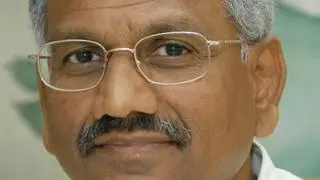Storing solar energy for later use has always been a big challenge. A young Indian scientist who is currently a postdoc in a US university and colleagues may have just overcome this hurdle, at last.
The device designed by Varun Kashyap and others at the University of Houston is not only capable of harvesting solar energy efficiently, but also storing it until it is required. The work can have a range of applications from power generation to desalination to distillation, the scientists said in a paper published in the journal Joule on Wednesday.
Kashyap, who completed his B.Tech from Visvesvaraya Technological University in 2015,is currently a Post-doctoral Associate at Cornell University.
How the device works?
Unlike solar panels and solar cells, which rely on photovoltaic technology for the direct generation of electricity, the hybrid device captures heat from the sun and stores it as thermal energy. It addresses some of the issues that have stalled wider-scale adoption of solar power, suggesting an avenue for using solar energy around-the-clock, despite limited sunlight hours, cloudy days and other constraints.
The work, carried out by Kashyap and other while at the lab of Hadi Ghasemi at the University of Houston, combines molecular energy storage and latent heat storage to produce an integrated harvesting and storage device for potential round the clock operation.. The researchers claimed a harvesting efficiency of 73 per cent at small-scale operation and as high as 90 per cent at large-scale operation.
Energy efficiency
Remarkably, at night, the energy stored by the hybrid system is recovered with an efficiency of 80 per cent and at a higher temperature than that of the day, in contrast to all of the state-of-the-art systems, the scientists claimed in the paper.
The high efficiency harvest is due, in part, to the ability of the device to capture the full spectrum of sunlight, harvesting it for immediate use and converting the excess into molecular energy storage, said Ghasemi, Bill D. Cook Associate Professor of Mechanical Engineering and a corresponding author for the paper.
Storage material
The device was synthesised using norbornadiene-quadricyclane as the molecular storage material, an organic compound that the researchers said demonstrates high specific energy and exceptional heat release while remaining stable over extended storage times, the scientists said in a statement.
T Randall Lee, UH chemistry professor and another corresponding author, said the device offers improved efficiency in several ways: The solar energy is stored in molecular form rather than as heat, which dissipates over time, and the integrated system also reduces thermal losses because there is no need to transport the stored energy through piping lines.
"During the day, the solar thermal energy can be harvested at temperatures as high as 120 degrees centigrade," said Lee. "At night, when there is low or no solar irradiation, the stored energy is harvested by the molecular storage material, which can convert it from a lower energy molecule to a higher energy molecule."
That allows the stored energy to produce thermal energy at a higher temperature at night than during the day - boosting the amount of energy available even when the sun is not shining, he said.







Comments
Comments have to be in English, and in full sentences. They cannot be abusive or personal. Please abide by our community guidelines for posting your comments.
We have migrated to a new commenting platform. If you are already a registered user of TheHindu Businessline and logged in, you may continue to engage with our articles. If you do not have an account please register and login to post comments. Users can access their older comments by logging into their accounts on Vuukle.